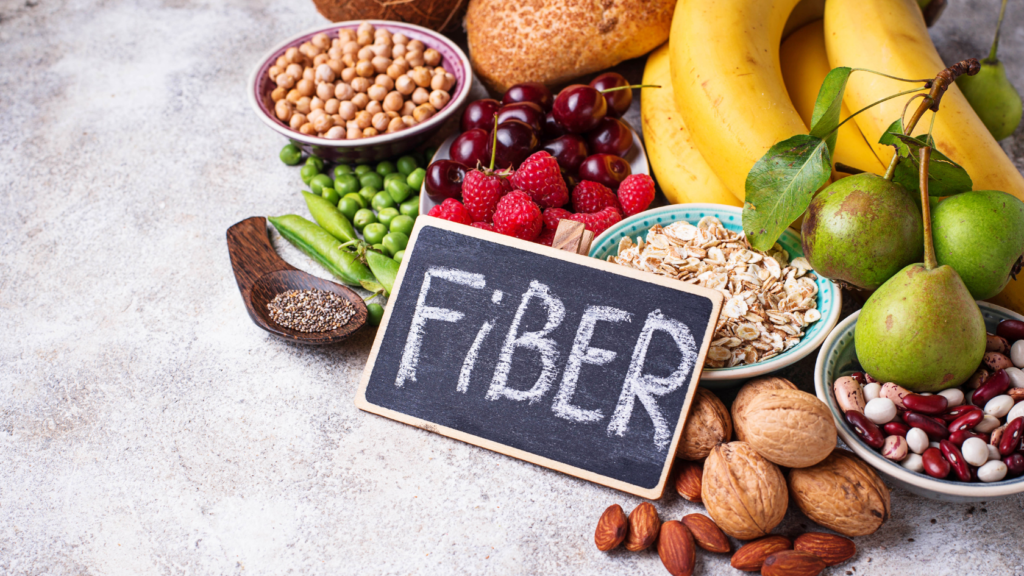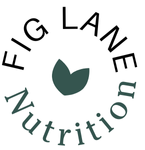By Parker Lane / October 11, 2024
Fiber, what the heck is it and where does it come from?
Fiber is a mostly indigestible component, at least for humans, found in plants.

Fortunately, the indigestibility of fiber is where we get a lot of the benefits. Fiber can reduce the risk of certain chronic health conditions, aids in bowel regularity, and helps to keep us satiated [1].
Unfortunately, 90% of women and 97% of men are not meeting dietary guidelines for fiber intake [2].
Function
There are two different types of fiber, soluble and insoluble fiber. Both come from plants just in different amounts depending on the source. Supplements typically offer one of the two sources.
Soluble fiber
Soluble in water, soluble fiber dissolves in liquids offering slower digestion.
Insoluble fiber
Not soluble in water, insoluble fiber helps form bulk in the stool and increases transit time through the intestines.
With both offering their own properties to support digestion, getting fiber from a variety of sources can help to ensure adequate intakes of both types of fiber.
Now fiber can slow down digestion of carbohydrates to support blood sugar control, help keep us full and can help to lower cholesterol levels. However, since we can’t digest fiber, it makes it to our gut microbiome where it can be fermented and produce beneficial products for us [3].
Recommended Dietary Fiber Intake

Based on caloric recommendation per age group the Dietary Guidelines for Americans, 2020-2025, recommendation for grams of fiber intake per day are:
| Women | Men | |
| Age 19-30 | 28 grams | 34 grams |
| Age 31-50 | 25 grams | 31 grams |
| Age 51+ | 22 grams | 28 grams |
However, since everyone has different calorie needs, not everyone in these age groups are going to need the same amount of fiber.
These fiber recommendations are determined based on 14 grams of fiber for every 1000 calories. So for example with food labels being based on a 2000 calorie diet the recommended fiber intake is determined by 2000 calories/1000 calories x 14 grams of fiber = 28 grams per day. Therefore, the percentage of daily fiber on the food label is based off 28 grams per day.
How to Increase Fiber Intake
Convinced to consume more? Great! But increasing fiber can be a bit tricky because it has to be done slowly and with plenty of water.
If you don’t get enough water and increase your fiber intake too quickly, it can lead to feeling gassy, bloated, and uncomfortable [1].
Plan ahead when increasing fiber intake and do it over 2-3 weeks, gradually increasing intake of high fiber foods over this duration.
Make sure you’re also tracking your water to make sure you’re meeting your daily needs. Generally, people need 8-10 glasses a day.
Excellent Sources of Fiber
Good sources of fiber contain 5.6 or more grams of fiber serving or >20% of the Daily value for fiber.
Protein
- Beans
- Lentils
- Tempeh
Carbohydrates
- Whole wheat pasta
- Pastas made from beans or lentils (brand dependent)
- Sorghum
- Bran breakfast cereal (brand dependent)
- Peas
- Sweet potato with the skin
- Winter squash
- Blackberries
- Raspberries
Fats
- Flax seeds
- Chia seeds
Good Sources of Fiber
Good sources of fiber contain 2.8-5.5 grams of fiber per serving or 10-19% of the daily value for fiber.
Protein
- TVP
- Vegan meat alternatives depending on brand (speaking of looking for what to use as a vegan meat alternatives, check out our recent blog post on the 11 Top Vegan Meat Alternatives)
Carbohydrates
- Oats
- Barley
- Farro
- Whole wheat bread
- Blueberries
- Strawberries
- Kiwi with the skin
- Oranges
- Grapefruit
- Pomelo
- Potatoes with the skin
- Cassava/yucca
- Corn
Fats
- Almonds
- Pecans
- Avocado
Vegetables
Most vegetables are going to offer some fiber however, some offer greater quantities for the serving size.
Final notes
While not everyone (people who are already getting enough or have medical history requiring them to restrict fiber) needs more fiber into their diet, many of us can benefit from more in our diets. For those over achievers out there, remember that balance is key, getting too much fiber, especially too quickly, could leave one with abdominal discomfort, gassy, and bloated or worse.
For those that may be considering supplements, there are supplements and food products that offer substantial amounts of fiber. While they do contribute towards your daily fiber intake, they are missing the extra benefit of consuming whole foods.
Something to consider is fiber from whole foods like fruits, vegetables, or whole grains come with other beneficials such as phytochemicals, vitamins, and minerals. These important benefits are where some of the potential protective factors from adequate fiber intake may come from.
Take Away
Majority of Americans are not getting recommended daily intakes of fiber in their diets [2]. Getting more doesn’t have to be hard if you know where to get it from and how to do it. Download the Fiber Source Foods List Here to help create a plan to get more fiber in your diet. While increasing fiber intake, make sure to do it gradually and with adequate amounts of fluids.

Pingback: 3 High Protein Plant Based Yogurt Alternatives [Dietitian Tested] - Fig Lane Nutrition
Pingback: Top 9 Plant Based Calcium Sources - Fig Lane Nutrition
Pingback: Plant-Based Carb List - Fig Lane Nutrition
Pingback: Spring Produce Guide - Fig Lane Nutrition
Pingback: Plant-based Smoothie Recipe Guide - Fig Lane Nutrition
Pingback: Cereals on a Plant-Based Diet: A Dietitian's Guide to Choosing Cereals - Fig Lane Nutrition